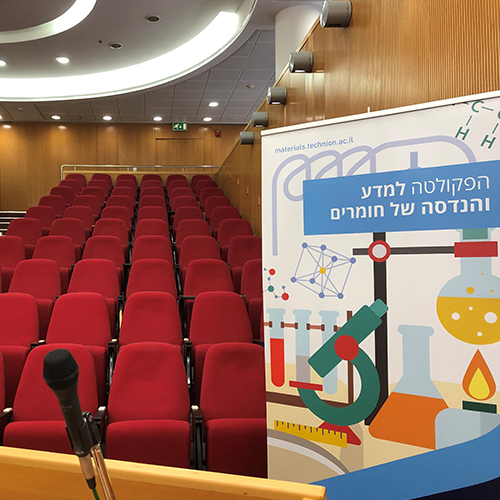
ביום חמישי, ה – 29 ביוני 2023 בשעה 14:30
אודיטוריום ע"ש דויד וואנג, בניין מידן, קומה 3
Ms. Natalie Rosen, PhD candidate
Department of Materials Science and Engineering, Technion – Israel Institute of Technology, Haifa
Natalie Rosen received both her BSc and MSc degrees at the Department of Materials Science and Engineering, Technion. Her MSc work on the encapsulation of inorganic phase change materials for energy storage has recently been published.
Templating in oil-in-water emulsions can be used to synthesize highly porous hydrogels. A “green”, environmentally friendly alternative should be used to prevent the need for removing the organic internal phase. Here, water-in-water (w/w) emulsion templates were formed by mixing aqueous solutions of poly(ethylene glycol) (PEG) (external phase) and of dextran (internal phase, IP). Adding F-127, a triblock copolymer with PEG endblocks and a poly(propylene oxide) midblock, to the external phase enhanced the stability of w/w emulsions containing 64 vol % IP through steric repulsion and adding alginic acid sodium salt enhanced it further. Porous hydrogel monoliths were synthesized through the free radical polymerization of monomers added to the PEG solution. The monomers included temperature-sensitive methacrylated F-127 (F-127-MA), temperature-sensitive N-isopropylacrylamide (NiPAAm), and strongly hygroscopic 2-acrylamido-2-methylpropane sulfonic acid (AMPS). The addition of monomers reduced the IP volume through water migration. No monomer diffusion was observed during polymerization (5 to 20 min) and the copolymerization of F-127-MA with either NiPAAm or AMPS was successful. This “green” process produced hydrogels with voids from 50 to 200 μm, densities from 0.1 to 0.2 g/cc, and water uptakes of up to 100 g/g. NiPAAm increased the temperature sensitivity by amplifying the reduction in uptake when heating from 5 to 50 °C. AMPS increased the overall uptake, especially between 35 and 50 °C.


